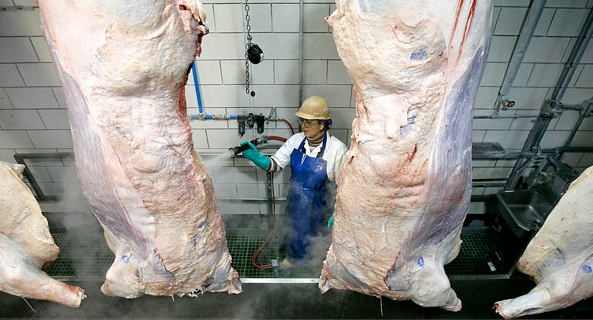In 1906 Upton Sinclair published The Jungle, a muckraking novel that alerted the American public to the horrors of the meatpacking industry of the time. Millions of workers and all American consumers have lived longer and better lives as a result. Conditions have improved drastically since then, but safety remains a continuing problem in industrialized meat processing. The slaughterhouse is still a dangerous place to work, and meat periodically becomes contaminated. The latest threat is from a toxic strain of e coli. This despite surprisingly clean plants, acid baths, steam vacuums, and sophisticated testing. Needless to say, when it comes to survival, the bacteria have the edge. To give you a view of the steps being taken, the Times published this photo:
It’s not often that photographs from the business page merit comment, much less awards. This one is typical. The focus is split between the objects in the foreground and the person in the background. Neither is the point of the picture, which is to show an industrial process. The diffusion is emotional as well. The photo communicates above all a sense of routine, ordinary, another-day-another-dollar activity; nothing to write a novel about. The conveyor belt moves things along, the worker directs a spray of water here or there, all against an unexceptionable background of white wall and grey pipes. You might be interested in how your meat is handled, but not to worry.
This ideological framing of viewer response is what is most typical about this business page photograph. What most interests me is the photograph’s distinctiveness, which is the brute presence of the carcasses. These amputated trunks are no longer animals, yet they are not yet slabs, much less cuts of meat. They are huge, visceral, bulging with muscle, bones, organs, everything that was alive but now is raw weight.
There is something scandalous about this image. One sees a packing plant and the anonymity of death; an industrial process, and the humiliation of being reduced completely to a condition of utility. Above all, there is again the massive reality of the carcasses. They are once living things now reduced to things, and yet they still resist somehow. Against the inevitable processing by both factory and camera, they remain massively, unintelligibly real. This is a scandal in the 21st century: against all attempts to transform everything into a virtual world of effortless consumption and digitized representation, some things refuse to surrender their reality.
Of course, those carcasses no longer exist, but the e coli do. The photograph of the carcasses can be a simple reminder that production is hidden during consumption; that is true of every form of production, including writing. Or it can be a scandal–literally, something that snares, in this case, that snares our attention. The hulking things in the photograph should snare our attention, they should offend the sensibility being constructed by the photograph, they should give offense to the idea that everything in our industrialized food production is doing fine as long as it is running smoothly.
Photograph by Kent Sievers/New York Times.

Where have I seen these colors before? This image really helps ya look at Francis Bacon…
http://francis-bacon.cx/popes/figurewithmeat.html
http://francis-bacon.cx/self_portraits/selfportrait732.html
production baths…
Thanks for your thoughtful reply…